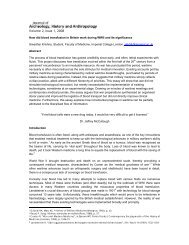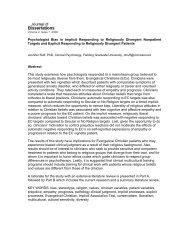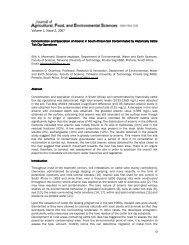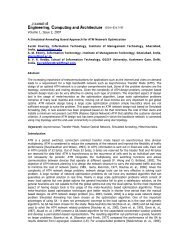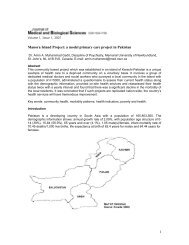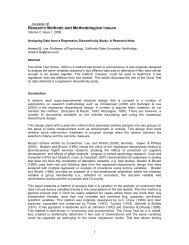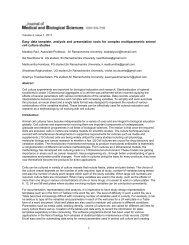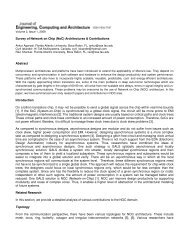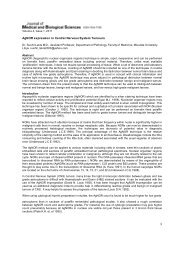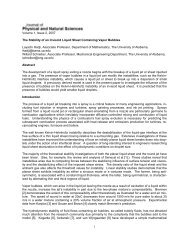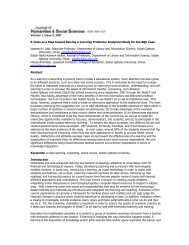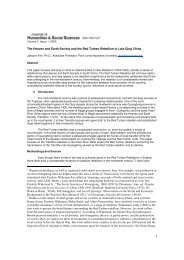Solubility of Nitrous Oxide in Amine Aqueous Solutions - Scientific ...
Solubility of Nitrous Oxide in Amine Aqueous Solutions - Scientific ...
Solubility of Nitrous Oxide in Amine Aqueous Solutions - Scientific ...
Create successful ePaper yourself
Turn your PDF publications into a flip-book with our unique Google optimized e-Paper software.
Volume 2, Issue 1, 2008<br />
<strong>Solubility</strong> <strong>of</strong> <strong>Nitrous</strong> <strong>Oxide</strong> <strong>in</strong> Am<strong>in</strong>e <strong>Aqueous</strong> <strong>Solutions</strong><br />
Basma Yaghi, Associate Pr<strong>of</strong>essor, Sultan Qaboos University, Oman. yaghi@squ.edu.om<br />
Omar Houache, Senior tra<strong>in</strong><strong>in</strong>g advisor, Oman Polypropylene, omar.houache@oman-pp.com<br />
Abstract<br />
The solubility <strong>of</strong> nitrous oxide (N 2 O) was measured <strong>in</strong> both pure water over the temperature range<br />
(5-80)°C, and <strong>in</strong> am<strong>in</strong>e aqueous solutions over the temperature range (20-60)°C under atmospheric<br />
pressure. The systems studied are monoethanolam<strong>in</strong>e (MEA), diethanolam<strong>in</strong>e (DEA), and<br />
diisopropanolam<strong>in</strong>e (DIPA) aqueous solutions. A new correlation was developed for the solubility <strong>of</strong><br />
N 2 O <strong>in</strong> water, while a semi-empirical model <strong>of</strong> the excess Henry's constant was used to correlate<br />
the solubility <strong>of</strong> N 2 O <strong>in</strong> am<strong>in</strong>e solutions. The parameters <strong>of</strong> the correlation were determ<strong>in</strong>ed from the<br />
measured solubility data. Generally, comparisons with experimental results from the reported<br />
literature <strong>in</strong>dicate that the obta<strong>in</strong>ed correlations are satisfactory for estimat<strong>in</strong>g the solubility <strong>of</strong> N 2 O<br />
<strong>in</strong> am<strong>in</strong>e solutions, which could be used to estimate the free-gas solubility <strong>of</strong> CO 2 <strong>in</strong> am<strong>in</strong>es.<br />
Keywords<br />
<strong>Nitrous</strong> <strong>Oxide</strong>, Monoethanolam<strong>in</strong>e, Diethanolam<strong>in</strong>e, Diisopropanolam<strong>in</strong>e, <strong>Aqueous</strong> Mixtures<br />
1. Introduction<br />
The question <strong>of</strong> acid gas removal has become <strong>in</strong>creas<strong>in</strong>gly significant <strong>in</strong> the treatment <strong>of</strong> natural<br />
gas, synthetic gas, ammonia production, Claus feed gases and landfill gases. A wide variety <strong>of</strong><br />
alkanolam<strong>in</strong>es such as monoethanolam<strong>in</strong>e (MEA), diglycolam<strong>in</strong>e (DGA), diethanolam<strong>in</strong>e (DEA),<br />
diisopropanolam<strong>in</strong>e (DIPA), triethanolam<strong>in</strong>e (TEA), N-methyldiethanolam<strong>in</strong>e (MDEA), 2-am<strong>in</strong>o-2-<br />
methyl-1-propanol (AMP), and 2-piperid<strong>in</strong>eethanol (2-PE) can be used as absorbents for acid gas<br />
removal processes [1].<br />
<strong>Solubility</strong> measurements are essential to the design <strong>of</strong> the absorption process but also to the<br />
measurement <strong>of</strong> the k<strong>in</strong>etic rates.<br />
The reactivity <strong>of</strong> CO 2 with alkanolam<strong>in</strong>e solutions makes the direct measurements <strong>of</strong> the<br />
physicochemical properties impossible [2]. The N 2 O analogy has been frequently used to estimate<br />
the solubility <strong>of</strong> CO 2 <strong>in</strong> am<strong>in</strong>e solutions [3-10].<br />
The relation that has been used to calculate the solubility <strong>of</strong> CO 2 <strong>in</strong> am<strong>in</strong>e solutions based on the<br />
N 2 O analogy is<br />
H CO<br />
= H<br />
N O<br />
HCO<br />
H<br />
2 2<br />
2 N 2 O<br />
(1.)<br />
H<br />
2<br />
( ) <strong>in</strong> water<br />
Where<br />
N O<br />
is the solubility <strong>of</strong> N 2 O <strong>in</strong> am<strong>in</strong>e solution.<br />
Calculat<strong>in</strong>g the physical solubility <strong>of</strong> CO 2 <strong>in</strong> am<strong>in</strong>es via the N 2 O analogy requires three<br />
measurements: the physical solubility <strong>of</strong> CO 2 and N 2 O <strong>in</strong> water, and the solubility <strong>of</strong> N 2 O <strong>in</strong> am<strong>in</strong>e.<br />
The numerous solubility data <strong>of</strong> N 2 O <strong>in</strong> water reported <strong>in</strong> the literature [5-9,11-21] and some <strong>of</strong><br />
those summarized <strong>in</strong> Table 1 are <strong>in</strong> certa<strong>in</strong> cases scattered. Reported solubility data, <strong>of</strong> N 2 O <strong>in</strong><br />
am<strong>in</strong>e aqueous solutions [1,4-7,9-11,14,17,23-26] are also scattered and <strong>in</strong>consistent, which results<br />
<strong>in</strong> scattered and <strong>in</strong>consistent data <strong>of</strong> the Henry's constant <strong>of</strong> N 2 O <strong>in</strong> water and am<strong>in</strong>e that may<br />
contribute to the <strong>in</strong>consistent results for the reaction k<strong>in</strong>etics reported <strong>in</strong> the literature [27].<br />
Accord<strong>in</strong>gly, the correct solubility <strong>of</strong> N 2 O <strong>in</strong> water and am<strong>in</strong>es is essential to estimate the correct<br />
1
solubility <strong>of</strong> CO 2 <strong>in</strong> an am<strong>in</strong>e, which <strong>in</strong> turn can be used <strong>in</strong> develop<strong>in</strong>g the correct reaction k<strong>in</strong>etic<br />
models. Therefore, the objective <strong>of</strong> this work is to measure the solubility <strong>of</strong> N 2 O <strong>in</strong> water over the<br />
temperature range (5-80) o C; and <strong>in</strong> pure MEA, DEA, and DIPA and their aqueous solutions over<br />
the temperature range (20-60)°C. A semi empirical model proposed by Wang et al. [17] and used<br />
by Tsai et al [10] will be used to correlate the solubility <strong>of</strong> N 2 O <strong>in</strong> am<strong>in</strong>e solutions. The parameters <strong>of</strong><br />
the correlation for each system would be determ<strong>in</strong>ed from the solubility <strong>of</strong> N 2 O measured <strong>in</strong> this<br />
study and compared with the available data <strong>in</strong> the open literature. The correlation may then be used<br />
to estimate the solubility <strong>of</strong> N 2 O <strong>in</strong> am<strong>in</strong>e aqueous solutions, (MEA, DEA, and DIPA) for wide<br />
temperature and concentration ranges. Us<strong>in</strong>g the N 2 O analogy the solubility data for CO 2 <strong>in</strong> these<br />
systems can be estimated.<br />
2. Experimental Section<br />
2.1 Experimental Apparatus<br />
The reaction cell, shown <strong>in</strong> Figure 1, with a volume <strong>of</strong> 275 cc has been used. It is composed <strong>of</strong> a<br />
double walled sta<strong>in</strong>less steel cyl<strong>in</strong>der closed at both ends by two metallic flanges. The upper flange<br />
is connected to a piston that can be adjusted to keep a constant pressure <strong>in</strong> the vessel. Pressure is<br />
measured us<strong>in</strong>g a digital pressure <strong>in</strong>dicator with an accuracy <strong>of</strong> ±0.3 mbar. A thermo-well holds a<br />
thermocouple to measure the temperature <strong>in</strong>side the vessel. N 2 O gas is <strong>in</strong>troduced through a tube<br />
connected to the upper flange. The lower part <strong>of</strong> the cell is equipped with a needle to feed the cell<br />
with solvent.<br />
A thermostatic liquid is circulated <strong>in</strong>side the double-walled cyl<strong>in</strong>der to control the temperature with<strong>in</strong><br />
±0.1 K. The apparatus is <strong>in</strong>stalled over a vibrator that ensures good external agitation.<br />
Figure 1. The reaction cell used for measur<strong>in</strong>g N 2 O solubility.<br />
2.2 Experimental Procedure<br />
All liquid solutions were prepared from distilled water and pure am<strong>in</strong>es supplied by Sigma Aldrich.<br />
Medical grade N 2 O with a purity <strong>of</strong> 99+% was used <strong>in</strong> all the solubility experiments.<br />
Water and am<strong>in</strong>es are degassed <strong>in</strong>dependently, and aqueous solutions are prepared. The amounts<br />
<strong>of</strong> water and am<strong>in</strong>es are known separately by differential weigh<strong>in</strong>g with<strong>in</strong> 0.001 g. The flask<br />
conta<strong>in</strong><strong>in</strong>g the solution is kept <strong>in</strong>side the thermostatic water bath at the same temperature <strong>of</strong> the<br />
2
experiment. The syr<strong>in</strong>ge is then connected to the reaction cell needle <strong>in</strong> order to transfer the<br />
solution by <strong>in</strong>jection.<br />
Accurate weight<strong>in</strong>g <strong>of</strong> the syr<strong>in</strong>ge before and after the transfer yields the mass <strong>of</strong> solution present <strong>in</strong><br />
the cell and then the liquid phase volume is calculated through the density correlation used by<br />
Glasscock [28].<br />
2.2.1 <strong>Solubility</strong><br />
The solubility <strong>of</strong> N 2 O <strong>in</strong> the aqueous am<strong>in</strong>e solutions was determ<strong>in</strong>ed by measur<strong>in</strong>g the volume<br />
change <strong>in</strong> the constant pressure equilibrium cell. Initially, the cell was purged with N 2 O at room<br />
temperature. The vent valve was then closed and heat<strong>in</strong>g started until the desired temperature was<br />
reached. A second purg<strong>in</strong>g with N 2 O at that temperature was done before the cell was sealed. The<br />
closed system was allowed to reach constant pressure and temperature before a known mass<br />
(approximately 50 g) <strong>of</strong> degassed liquid was <strong>in</strong>jected <strong>in</strong>to the cell and pressure (P i ) and volume (V i )<br />
were recorded. The vibrator was then started and the system was assumed to be at equilibrium<br />
when the temperature and volume stopped chang<strong>in</strong>g after a m<strong>in</strong>imum <strong>of</strong> 80 m<strong>in</strong>utes <strong>of</strong> cont<strong>in</strong>uous<br />
mix<strong>in</strong>g. Mov<strong>in</strong>g the piston to the desired position allows the f<strong>in</strong>al pressure (P f ) to be ma<strong>in</strong>ta<strong>in</strong>ed<br />
constant and equal to (P i ). Henry’s law constant, H, was then calculated by the follow<strong>in</strong>g equation<br />
H<br />
V V<br />
( Pf<br />
− PW<br />
− PA<br />
)<br />
V V<br />
[ PV − ( P − P − P ) V ]<br />
= (2.)<br />
i<br />
i<br />
f<br />
W<br />
A<br />
f<br />
⋅V<br />
RT<br />
V<br />
Where P<br />
i<br />
and P<br />
f<br />
are the <strong>in</strong>itial and f<strong>in</strong>al pressures, respectively; P<br />
W<br />
and<br />
am<strong>in</strong>e vapour pressures, respectively; V<br />
i<br />
and<br />
V l the liquid volume; R is the ideal gas constant; and T is the absolute temperature.<br />
l<br />
V<br />
P<br />
A<br />
are the water and<br />
V<br />
f<br />
are the <strong>in</strong>itial and f<strong>in</strong>al gas volumes, respectively;<br />
3. Results and Discussion<br />
<strong>Solubility</strong> was calculated <strong>in</strong> terms <strong>of</strong> Henry’s law constant, H, and solubility C. The vapour pressure<br />
<strong>of</strong> the pure am<strong>in</strong>es at different temperatures was neglected <strong>in</strong> all calculations [29], whilst the vapour<br />
pressure <strong>of</strong> pure water at different temperatures was calculated us<strong>in</strong>g<br />
6597.6<br />
ln( P V W<br />
/ Pa) = 55.147 − − 4.3804ln( T / K)<br />
which is correlated from data given <strong>in</strong> Perry’s<br />
T / K<br />
Chemical Eng<strong>in</strong>eer<strong>in</strong>g Handbook [30], with the average regression error over the temperature range<br />
0 to 120 o C be<strong>in</strong>g less than 0.1 %.<br />
3.1 <strong>Solubility</strong> <strong>of</strong> N 2 O <strong>in</strong> water<br />
The measured solubilities <strong>of</strong> N 2 O <strong>in</strong> water reported <strong>in</strong> the literature and those obta<strong>in</strong>ed <strong>in</strong> this study<br />
are summarized <strong>in</strong> Table 1. In Figure 2, a comparison between the literature values [5-8,11-<br />
14,18,22] and those obta<strong>in</strong>ed <strong>in</strong> this study for N 2 O solubility <strong>in</strong> water are shown. The solid l<strong>in</strong>e<br />
represents calculated values us<strong>in</strong>g the follow<strong>in</strong>g equation.<br />
6 ⎛ − 2372 ⎞<br />
H N O , W<br />
= 10.86×<br />
10 exp⎜<br />
⎟<br />
(3.)<br />
2<br />
⎝ T ⎠<br />
H ,<br />
Where<br />
N2O<br />
W<br />
is the Henry’s constant <strong>in</strong> Pa.m 3 .mol -1 and T the absolute temperature.<br />
The above equation is the correlation <strong>of</strong> the solubility <strong>of</strong> N 2 O <strong>in</strong> water as a function <strong>of</strong> temperature<br />
from experimental data obta<strong>in</strong>ed <strong>in</strong> this work. The standard deviation was found to be 0.24.<br />
Table 1. <strong>Solubility</strong> <strong>of</strong> N 2 O <strong>in</strong> water<br />
3
<strong>Solubility</strong> <strong>of</strong> N 2 O <strong>in</strong> Water (Pa.m 3 .mol -1 )<br />
T/K Ref. 4 Ref. 5 Ref. 6 Ref. 7 Ref. 11 Ref. 12 Ref. 13 Ref. 17 Ref. 20 Ref. 21<br />
This<br />
work<br />
278 2 026<br />
283 2 433<br />
288 2 992 2 897 3 172 2 887<br />
291.2 3 344<br />
292 3 484<br />
292.9 3 333 2 589.9<br />
293 3 482 3 425 3 321 3 506 3 694 3 306<br />
298 4 169 4 132 3 911 4 176 3 982 4 101 4 179 4 314 3 821<br />
298.6 3 774 3 809.8<br />
303 4 950 4 350 4 408 4 406 4 315<br />
306 4 900 4 982 4 975<br />
308 5 284 5 263 4 710 4 899<br />
312.9 5 917 4 249.6<br />
313 6 061 5 020 6 339 5 725 5 900 5 541<br />
318 6 993 4 689.3 6 243<br />
322.6 7 143 5 166.6<br />
322.9 7 407<br />
323 5 371 7 254.2 7 214 7 260 7 264 7 007<br />
328 7837<br />
333 9 105 8 737<br />
338 9 708<br />
340 10 309<br />
343 10 754<br />
348 12 348 11 878<br />
353 12 821 11 220 13 083<br />
355.4 14 085<br />
4
From Figure 2, it is seen that the measured solubilities <strong>of</strong> N 2 O <strong>in</strong> water are <strong>in</strong> good agreement with<br />
the values reported by Al-Ghawas et al [7] over the temperature range (15-40) o C, and with the<br />
values reported by Versteeg et al [6] over the temperature range (45-80) o C.<br />
Figure 2. Comparison between literature values on solubility <strong>of</strong> N 2 O <strong>in</strong> water and experimental<br />
values <strong>of</strong> this work.<br />
3.2 <strong>Solubility</strong> <strong>of</strong> N 2 O <strong>in</strong> pure am<strong>in</strong>es<br />
Experimental solubility data for N 2 O <strong>in</strong> pure MEA, DEA, and DIPA was determ<strong>in</strong>ed over the<br />
temperature range (20-60) o C by the above-mentioned method. The experimental values for each <strong>of</strong><br />
the am<strong>in</strong>es have been correlated as a quadratic function <strong>of</strong> temperature us<strong>in</strong>g<br />
2<br />
H = a + bT cT<br />
(4.)<br />
N 2 O ,Am<strong>in</strong>e<br />
+<br />
Where<br />
H<br />
N2O,<br />
a m<strong>in</strong> e<br />
is the Henry’s constant <strong>in</strong> Pa.m 3 .mol -1 and T the absolute temperature.<br />
Parameters a, b, and c for the three pure am<strong>in</strong>es (MEA, DEA, and DIPA) were calculated and<br />
tabulated <strong>in</strong> Table 2. The average regression deviations, for temperatures between 20 and 60 °C,<br />
between the calculated solubilities <strong>of</strong> N 2 O <strong>in</strong> pure am<strong>in</strong>es and experimental data is
Table 2. Parameters <strong>in</strong> equation 4 for the solubility <strong>of</strong> N 2 O <strong>in</strong> pure alkanolam<strong>in</strong>es.<br />
a b c % Error<br />
N 2 O-MEA -12 922 63 -0.0362 0.22<br />
N 2 O-DEA 47 103 -305 0.5337 0.4<br />
N 2 O-DIPA -24 129 128.6 -0.1423 0.65<br />
Figure 3. Experimental and calculated solubility <strong>of</strong> N 2 O <strong>in</strong> pure MEA, DEA and DIPA.<br />
3.3 <strong>Solubility</strong> <strong>of</strong> N 2 O <strong>in</strong> am<strong>in</strong>e aqueous solutions<br />
The measured solubilities <strong>of</strong> N 2 O <strong>in</strong> am<strong>in</strong>e aqueous solutions over the temperature range (20 to 60)<br />
o C are presented <strong>in</strong> Table 3. The concentrations <strong>of</strong> am<strong>in</strong>e vary between 5% and 30% (w/w).<br />
A semi empirical model proposed by Wang et al [17] was used to correlate the solubility <strong>of</strong> N 2 O <strong>in</strong><br />
am<strong>in</strong>e solutions. In this method, the excess Henry's coefficient for the b<strong>in</strong>ary system has the<br />
follow<strong>in</strong>g form<br />
= ln H − Φ ln H − Φ H<br />
(5.)<br />
( ) ( ) ( )<br />
R<br />
N O m A N O,<br />
A W N O,<br />
W<br />
H<br />
N O , m<br />
, H<br />
N O , A<br />
, 2<br />
2<br />
2<br />
ln<br />
H ,<br />
Where<br />
, and<br />
2<br />
2<br />
N 2O<br />
W<br />
are Henry’s constant <strong>of</strong> N 2 O <strong>in</strong> the am<strong>in</strong>e aqueous<br />
solution <strong>in</strong> pure solvent A and <strong>in</strong> water, respectively. Φ<br />
A<br />
, and Φ<br />
W<br />
are the volume fractions <strong>of</strong><br />
6
solvent A and water, respectively. From eq. 5, the excess Henry's quantity R can be calculated from<br />
the measured<br />
N O m<br />
and the estimated<br />
N O A<br />
, and<br />
N O W<br />
.<br />
H ,<br />
2<br />
H ,<br />
2<br />
H ,<br />
The calculated excess Henry's quantity is then correlated as a function <strong>of</strong> volume fraction,<br />
R = Φ Φ α<br />
(6.)<br />
ij<br />
i<br />
j<br />
ij<br />
Where the two-body <strong>in</strong>teraction parameter, α<br />
ij<br />
, is temperature dependent. It has assumed the<br />
expression<br />
2<br />
α c + c T + c T + c Φ<br />
(7.)<br />
ij<br />
=<br />
1 2 3 4<br />
W<br />
Where c 1 , c 2 , c 3 , and c 4 are parameters for each b<strong>in</strong>ary system and determ<strong>in</strong>ed from<br />
correspond<strong>in</strong>g solubility data <strong>of</strong> N 2 O <strong>in</strong> (H 2 O+MEA), (H 2 O+DEA), and (H 2 O+DIPA) solutions.<br />
<strong>Solubility</strong> <strong>of</strong> N 2 O <strong>in</strong> pure water,<br />
am<strong>in</strong>es,<br />
H<br />
N O , A<br />
2<br />
H<br />
N 2O<br />
, W<br />
2<br />
, is calculated us<strong>in</strong>g eq. 3. The solubility <strong>of</strong> N 2 O <strong>in</strong> pure<br />
, is calculated us<strong>in</strong>g eq. 4 and the parameters <strong>in</strong> Table 2.<br />
Table 3. <strong>Solubility</strong> <strong>of</strong> N 2 O <strong>in</strong> alkanolam<strong>in</strong>e aqueous solutions<br />
H N2O (Pa.m 3 .mol -1 )<br />
C am<strong>in</strong>e (Weight %) MEA DEA DIPA<br />
20 o C<br />
5 3 782 3 722 3 612<br />
10 3 826 3 778 3 827<br />
15 3 869 3 834 4 041<br />
20 3 912 3 890 4 256<br />
25 3 956 3 946 4 471<br />
30 4 001 4 002 4 686<br />
30 o C<br />
5 4 698 4 676 4 762<br />
10 4 752 4 732 4 977<br />
15 4 794 4 788 5 191<br />
20 4 828 4 844 5 406<br />
25 4 891 4 900 5 621<br />
30 4 975 4 956 5 836<br />
7
Table 3 cont<strong>in</strong>ues<br />
H N2O (Pa.m 3 .mol -1 )<br />
C am<strong>in</strong>e (Weight %) MEA DEA DIPA<br />
40 o C<br />
5 5 624 5 630 5 912<br />
10 5 687 5 686 6 127<br />
15 5 723 5 742 6 341<br />
20 5 748 5 798 6 556<br />
25 5 787 5 854 6 771<br />
30 5 821 5 910 6 986<br />
50 o C<br />
5 7 140 7 084 7 062<br />
10 7 283 7 140 7 277<br />
15 7 326 7 196 7 491<br />
20 7 467 7 252 7 706<br />
25 7 508 7 308 7 921<br />
30 7 553 7 364 8 136<br />
60 o C<br />
5 8 845 8 738 8 212<br />
10 8 889 8 794 8 427<br />
15 8 932 8 850 8 641<br />
20 8 976 8 906 8 856<br />
25 9 019 8 962 9 071<br />
30 8 863 9 018 9 286<br />
Us<strong>in</strong>g the solubility data obta<strong>in</strong>ed <strong>in</strong> this study, i.e. Table 3, the parameters, c 1 , c 2 , c 3 , and c 4 <strong>in</strong> eq. 7<br />
are determ<strong>in</strong>ed for each am<strong>in</strong>e solution system; the results are presented <strong>in</strong> Table 4. Comparisons<br />
<strong>of</strong> the calculated and experimental solubilities <strong>of</strong> N 2 O <strong>in</strong> am<strong>in</strong>e solutions are shown <strong>in</strong> Figures 4, 6<br />
and 8.<br />
8
For the MEA + H 2 O system, the experimental values are shown <strong>in</strong> Figure 4 along with the results <strong>of</strong><br />
the solubility calculation us<strong>in</strong>g eq. 7.<br />
Figure 5 shows the application <strong>of</strong> the correlation obta<strong>in</strong>ed <strong>in</strong> this work, the correlation <strong>of</strong> Wang et al<br />
[17] and that <strong>of</strong> Tsai et al [10] to solubility data published by Little et al [24] over the temperature<br />
range <strong>of</strong> 30 to 75 °C.<br />
Table 4. Parameters <strong>in</strong> eq. 7 for water-am<strong>in</strong>e systems.<br />
c 1 c 2 c 3 c 4<br />
H 2 O-MEA 89.2 -5.54E-01 8.670E-04 0.443<br />
H 2 O-DEA 56.8 -3.53E-01 5.490E-04 0.948<br />
H 2 O-DIPA -40.5 3.17E-01 -5.57E-04 -2.59<br />
The figure shows that the correlation <strong>of</strong> Wang yields poor results for the solubility calculations at<br />
temperatures above 30 °C. The dotted l<strong>in</strong>es <strong>in</strong> Figure 5 show the calculated values from the<br />
correlation <strong>of</strong> Tsai et al. It is clear <strong>in</strong> Figure 5 that the calculated values from the present correlation<br />
as well as those obta<strong>in</strong>ed from Tsai et al’s approach experimental values up to 60 o C.<br />
Figure 4. Calculated solubility <strong>of</strong> N 2 O <strong>in</strong> aqueous MEA solutions.<br />
9
Figure 5. Comparison between calculated and experimental literature solubility data <strong>of</strong> N 2 O <strong>in</strong><br />
aqueous MEA solutions.<br />
Experimental solubilities <strong>of</strong> N 2 O <strong>in</strong> DEA + H 2 O are shown <strong>in</strong> Figure 6. There is a satisfactory<br />
agreement between experimental and correlation data at all temperatures and concentrations. The<br />
results <strong>of</strong> calculations, us<strong>in</strong>g equation 7, <strong>of</strong> the present work (solid l<strong>in</strong>es), Tsai et al [10] (dotted<br />
l<strong>in</strong>es), and Wang et al. [17] (broken l<strong>in</strong>es) correlations when applied to experimental data <strong>of</strong> Little et<br />
al [24] are shown <strong>in</strong> Figure 7. The correlation <strong>of</strong> Wang et al [17] shows very poor predictions at lowtemperature<br />
(15, 20, 25, and 30 °C) solubility data. On the other hand, results obta<strong>in</strong>ed by Tsai et al<br />
[10] correlation deviate from experimental values when the temperature is <strong>in</strong>creased above 45 o C.<br />
However, the calculated Henry's constant values us<strong>in</strong>g equation 7 are consistent with most <strong>of</strong> the<br />
data <strong>of</strong> Little et al [24] at all temperatures and concentrations <strong>of</strong> DEA.<br />
10
Figure 6. Calculated solubility <strong>of</strong> N 2 O <strong>in</strong> aqueous DEA solutions.<br />
Figure 7. Comparison between calculated and experimental literature solubility data <strong>of</strong> N 2 O <strong>in</strong><br />
aqueous DEA solutions.<br />
For the DIPA + H 2 O system, the experimental values are presented <strong>in</strong> Figure 8 along with the<br />
results <strong>of</strong> the solubility calculation us<strong>in</strong>g eq. 7. There is a good agreement between experimental<br />
data and correlation for temperatures lower than 50 o C, while slightly lower values at high<br />
concentrations are shown when compared with the experimental values obta<strong>in</strong>ed <strong>in</strong> this study.<br />
11
Figure 9 shows the application <strong>of</strong> the correlation to data taken from solubility data <strong>of</strong> Versteeg et al<br />
[6] over the temperature range from 25 to 60 °C. The solid l<strong>in</strong>es, the broken l<strong>in</strong>es, and the dotted<br />
l<strong>in</strong>es <strong>in</strong> Figure 9 are calculated values from the use <strong>of</strong> equation 7, Wang et al. [17] correlation, and<br />
<strong>of</strong> Tsai et al. [10] correlation, respectively. There is satisfactory agreement between experimental<br />
data and the three correlations results for all temperatures and concentrations. Though, the<br />
correlation <strong>of</strong> Tsai et al. [10] gives high-calculated values at temperature <strong>of</strong> 60 o C and concentration<br />
above 2g/cm 3 .<br />
Figure 8. Calculated solubility data <strong>of</strong> N 2 O <strong>in</strong> aqueous DIPA solutions.<br />
Figure 9. Comparison between calculated and experimental literature solubility data <strong>of</strong> N 2 O <strong>in</strong> aqueous DIPA<br />
solutions.<br />
12
4. Conclusions<br />
The solubility <strong>of</strong> nitrous oxide <strong>in</strong> pure water over the temperature range (5 to 80) o C was measured<br />
and a new correlation was developed. <strong>Solubility</strong> data <strong>of</strong> N 2 O <strong>in</strong> three pure am<strong>in</strong>es MEA, DEA, and<br />
DIPA with<strong>in</strong> the temperature range (20 to 60) o C shows that the solubility <strong>of</strong> N 2 O <strong>in</strong> these am<strong>in</strong>es<br />
could be represented by a quadratic function <strong>of</strong> temperature. <strong>Solubility</strong> <strong>of</strong> N 2 O <strong>in</strong> the abovementioned<br />
am<strong>in</strong>e solutions was measured over the temperature range (20 to 60) °C. The<br />
concentration <strong>of</strong> am<strong>in</strong>e ranges from (5 to 30) % mass. A semi-empirical model <strong>of</strong> the excess<br />
Henry's constant was used to correlate the solubility <strong>of</strong> N 2 O <strong>in</strong> these am<strong>in</strong>e solutions. The<br />
parameters <strong>of</strong> the correlation were determ<strong>in</strong>ed from the solubility <strong>of</strong> N 2 O obta<strong>in</strong>ed <strong>in</strong> this study. The<br />
obta<strong>in</strong>ed correlation has been shown to represent reasonably well the solubility <strong>of</strong> N 2 O <strong>in</strong> the three<br />
am<strong>in</strong>e aqueous solutions. In process design, the obta<strong>in</strong>ed correlations are <strong>in</strong> general satisfactory for<br />
estimat<strong>in</strong>g the solubility <strong>of</strong> N 2 O <strong>in</strong> am<strong>in</strong>e solutions that could be used to estimate the correct freegas<br />
solubility <strong>of</strong> CO 2 <strong>in</strong> am<strong>in</strong>es.<br />
Acknowledgments<br />
The authors acknowledge Sultan Qaboos University for fund<strong>in</strong>g the research through the University<br />
Internal Grant # IG/ENG/PMRE/03/01.<br />
References<br />
[1] A.L. Kohl, F.C. Riesenfeld, Gas Purification. 4 th ed., Gulf, Houston, 1985.<br />
[2] M.K. Abu-Arabi, A. Tamimi, A.M. AlJarrah, <strong>Solubility</strong> and Diffusivity <strong>of</strong> CO 2 <strong>in</strong> Triethanolam<strong>in</strong>e<br />
<strong>Solutions</strong>. J. Chem. Eng. Data, 45 (2001) 1125-1129.<br />
[3] M.K. Abu-Arabi, A.M. AlJarrah, M. El-Eideh, A. Tamimi, Physical <strong>Solubility</strong> and Diffusivity <strong>of</strong><br />
CO 2 <strong>in</strong> Diethanolam<strong>in</strong>e <strong>Solutions</strong>. J. Chem. Eng. Data, 46 (2001) 516-521.<br />
[4] J.K.A. Clarke, K<strong>in</strong>etics <strong>of</strong> Absorption <strong>of</strong> Carbon Dioxide <strong>in</strong> Monoethanolam<strong>in</strong>e <strong>Solutions</strong> at<br />
Short Contact Times. Ind. Eng. Chem. Fund., 3 (1964) 239-245.<br />
[5] N.M. Haimour, O.C. Sandall, Absorption <strong>of</strong> Carbon Dioxide <strong>in</strong>to <strong>Aqueous</strong><br />
Methyldiethanolam<strong>in</strong>e. Chem. Eng. Sci., 39 (1984) 1791-1796.<br />
[6] G.F. Versteeg, W.P.M. van Swaaij, <strong>Solubility</strong> and Diffusivity <strong>of</strong> Acid Gases (CO 2 , N 2 O) <strong>in</strong><br />
<strong>Aqueous</strong> Alkanolam<strong>in</strong>e <strong>Solutions</strong>. J. Chem. Eng. Data, 33 (1988) 29-34.<br />
[7] H.A. Al-Ghawas, D.P. Hagewiesche, G. Ruiz-Ibanez, O.C. Sandall, Physicochemical<br />
Properties Important for Carbon Dioxide Absorption <strong>in</strong> <strong>Aqueous</strong> Methyldiethanolam<strong>in</strong>e. J. Chem.<br />
Eng. Data, 34 (1989) 385-391<br />
[8] S. Xu, F.D. Otto, A.E. Mather, Physical Properties <strong>of</strong> <strong>Aqueous</strong> AMP <strong>Solutions</strong>. J. Chem. Eng.<br />
Data, 36 (1991) 71-75.<br />
[9] A.K. Saha, S.S. Bandyopadhyay, A.K. Biswas, <strong>Solubility</strong> and Diffusivity <strong>of</strong> N 2 O and CO 2 <strong>in</strong><br />
<strong>Aqueous</strong> <strong>Solutions</strong> <strong>of</strong> 2-Am<strong>in</strong>o-2- methyl-1-propanol. J. Chem. Eng. Data , 38 (1993) 78-82.<br />
[10] T. Tsai, J. Ko, H. Wang, C. Li, M. Li, <strong>Solubility</strong> <strong>of</strong> nitrous oxide <strong>in</strong> alkanolam<strong>in</strong>e aqueous<br />
solutions. J. Chem. Eng. Data, 45 (2000) 341-347.<br />
[11] N.M. Haimour, <strong>Solubility</strong> <strong>of</strong> N 2 O <strong>in</strong> <strong>Aqueous</strong> <strong>Solutions</strong> <strong>of</strong> Diethanalam<strong>in</strong>e at Different<br />
Temperatures. J. Chem. Eng. Data, 35 (1990) 177-178.<br />
[12] E.B. R<strong>in</strong>ker and O.C. Sandall, <strong>Solubility</strong> <strong>of</strong> <strong>Nitrous</strong> <strong>Oxide</strong> <strong>in</strong> <strong>Aqueous</strong> <strong>Solutions</strong> <strong>of</strong><br />
Methyldiethanolam<strong>in</strong>e, Diethanolam<strong>in</strong>e and Mixtures <strong>of</strong> Methyldiethanolam<strong>in</strong>e and<br />
Diethanolam<strong>in</strong>e, Chem. Eng. Commun., 144 (1996) 85-94.<br />
13
[13] R. A. Davis, B.J. Poga<strong>in</strong>is, <strong>Solubility</strong> <strong>of</strong> <strong>Nitrous</strong> <strong>Oxide</strong> <strong>in</strong> <strong>Aqueous</strong> Blends <strong>of</strong> N-<br />
Methyldiethanolam<strong>in</strong>e and 2-Am<strong>in</strong>o-2-methyl-1-propanol. J. Chem. Eng. Data, 40 (1995) 1249-<br />
1251.<br />
[14] M.H. Li, M.D. Lai, <strong>Solubility</strong> and diffusivity <strong>of</strong> N 2 O and CO 2 <strong>in</strong> (Monoethanolam<strong>in</strong>e + N-<br />
Methyldiethanolam<strong>in</strong>e + Water) and <strong>in</strong> (Monoethanolam<strong>in</strong>e + 2-Am<strong>in</strong>o-2-methyl-1-propanol +<br />
Water). J. Chem. Eng. Data, 40 (1995) 486-492.<br />
[15] A.E. Markham, K.A. Kobe, The <strong>Solubility</strong> <strong>of</strong> Carbon Dioxide and <strong>Nitrous</strong> <strong>Oxide</strong> <strong>in</strong> <strong>Aqueous</strong><br />
Salt <strong>Solutions</strong>. Ind. Eng. Chem. 63 (1941) 449-454.<br />
[16] G.E.H. Joosten, P.V. Danckwerts, <strong>Solubility</strong> and Diffusivity <strong>of</strong> <strong>Nitrous</strong> <strong>Oxide</strong> <strong>in</strong> Equimolar<br />
Potassium Carbonate, Potassium Bicarbonate <strong>Solutions</strong> at 25 o C and 1 atm. J. Chem. Eng. Data,<br />
17 (1972) 452-454.<br />
[17] Y.W. Wang, S. Xu, F.D. Otto, A.E. Mather, <strong>Solubility</strong> <strong>of</strong> N 2 O <strong>in</strong> Alkanolam<strong>in</strong>es and <strong>in</strong> Mixed<br />
Solvents. Chem. Eng. J., 48 (1992) 31-40.<br />
[18] E.B. R<strong>in</strong>ker, S.S. Ashour, O.C. Sandall, K<strong>in</strong>etics and Model<strong>in</strong>g <strong>of</strong> Carbon Dioxide Absorption<br />
<strong>in</strong>to <strong>Aqueous</strong> <strong>Solutions</strong> <strong>of</strong> N-Methyldiethanolam<strong>in</strong>e. Chem. Eng. Sci. 50 (1995) 755-768.<br />
[19] A. Yasunishi, F. Yoshida, <strong>Solubility</strong> <strong>of</strong> Carbon Dioxide <strong>in</strong> <strong>Aqueous</strong> Electrolyte <strong>Solutions</strong>. J.<br />
Chem. Eng. Data, 24 (1979) 11-14.<br />
[20] E. Sada, H. Kumazawa, M.A. Butt, <strong>Solubility</strong> and Diffusivity <strong>of</strong> Gases <strong>in</strong> <strong>Aqueous</strong> <strong>Solutions</strong> <strong>of</strong><br />
Am<strong>in</strong>es. J. Chem. Eng. Data, 23 (1978) 161-163.<br />
[21] G.J. Brown<strong>in</strong>g, R.H. Weiland, Physical <strong>Solubility</strong> <strong>of</strong> Carbon Dioxide <strong>in</strong> <strong>Aqueous</strong> Alkanolam<strong>in</strong>e<br />
via <strong>Nitrous</strong> <strong>Oxide</strong> Analogy. J. Chem. Eng. Data, 39 (1994) 817-822.<br />
[22] B. Munder, H. Lidal, O.C. Sandall, Effect <strong>of</strong> Carbon Dioxide load<strong>in</strong>g on the solubility <strong>of</strong><br />
<strong>Nitrous</strong> <strong>Oxide</strong> <strong>in</strong> <strong>Aqueous</strong> <strong>Solutions</strong> <strong>of</strong> 2-(tert-Butylam<strong>in</strong>e)ethanol. J. Chem. Eng. Data, 45 (2000)<br />
1195-1200.<br />
[23] R.L. Little, G.F. Versteeg, W.P.M. van Swaaij, <strong>Solubility</strong> and Diffusivity Data for the<br />
Absorption <strong>of</strong> COS, CO 2 , and N 2 O <strong>in</strong> Am<strong>in</strong>e <strong>Solutions</strong>. J. Chem. Eng. Data, 37 (1992) 49-55.<br />
[24] E. Sada, S. Kito, Solubilities <strong>of</strong> Gases <strong>in</strong> <strong>Aqueous</strong> Monoethanolam<strong>in</strong>e <strong>Solutions</strong>. Kagaku<br />
Kogaku, 36 (1972) 218-220.<br />
[25] E. Sada, H. Kumazawa, M.A. Butt, <strong>Solubility</strong> <strong>of</strong> Gases <strong>in</strong> <strong>Aqueous</strong> <strong>Solutions</strong> <strong>of</strong> Am<strong>in</strong>e. J.<br />
Chem. Eng. Data, 22 (1977) 277-278.<br />
[26] G.F. Versteeg, M.H. Oyevaar, The Reaction Between CO 2 and Diethanolam<strong>in</strong>e at 298 K.<br />
Chem. Eng. Sci., 44 (1989) 1264-1268.<br />
[27] P.M.M. Blauwh<strong>of</strong>f, G.F. Versteeg, W.P.M. van Swaaij, A Study <strong>of</strong> the Reaction Between CO 2<br />
and Alkanolam<strong>in</strong>es <strong>in</strong> <strong>Aqueous</strong> <strong>Solutions</strong>. Chem. Eng. Sci., 39 (1984) 207-225.<br />
[28] D.A. Glasscork, Model<strong>in</strong>g and Experimental study <strong>of</strong> Carbon Dioxide Absorption Into<br />
<strong>Aqueous</strong> Alkanolam<strong>in</strong>e. PhD dissertation, the University <strong>of</strong> Texas, Aust<strong>in</strong>, Aust<strong>in</strong> TX, 1990.<br />
[29] A.L. Kohl, F.G. Riesenfeld, Gas Purification. 2 nd ed., Gulf, Houston, 1974, Chapter 2.<br />
[30] G. Perry, Perry’s Chemical Eng<strong>in</strong>eer<strong>in</strong>g Handbook, 6 th ed., McGraw Hill, 1997, pp. 2.49.<br />
14



